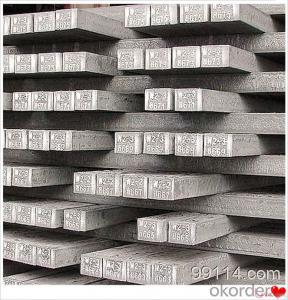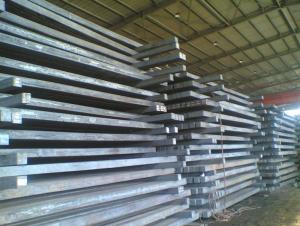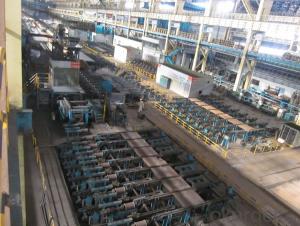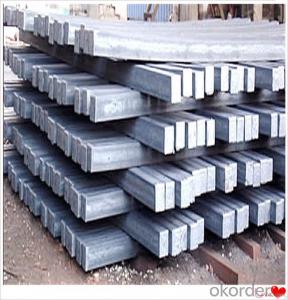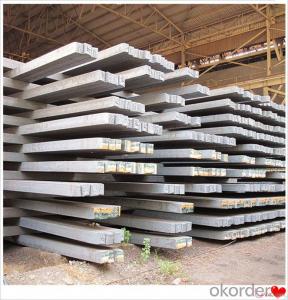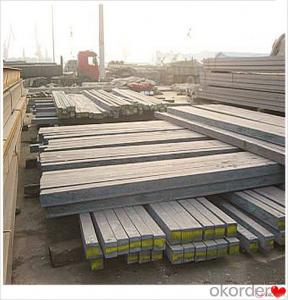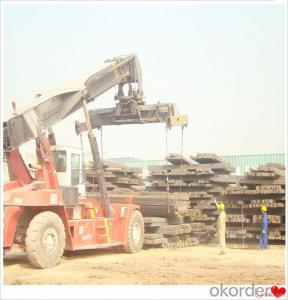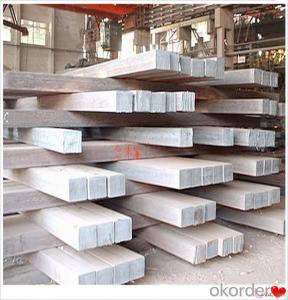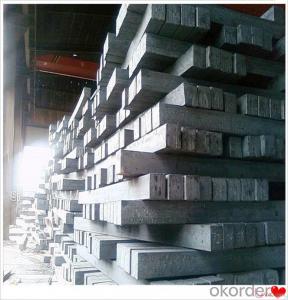Steel Billets Q195-Q235 20mnsi Q235 Q275 Q345 for Fireplace Billet Steel
- Loading Port:
- Dalian
- Payment Terms:
- TT OR LC
- Min Order Qty:
- 100 m.t.
- Supply Capability:
- 50000 m.t./month
OKorder Service Pledge
OKorder Financial Service
You Might Also Like
Steel Billets Q195-Q235 20mnsi Q235 Q275 Q345 for Fireplace Billet Steel
Description
Reference Price:$260/ton Mn 0.3%-0.6%
Rectangular billet continuous casting billet and mainly general carbon steel, low carbon low silicon cold-rolled material, high quality carbon structural steel, high strength low alloy steel, special steel, etc.
The billet is mainly divided into two kinds from the shape:
Slab: cross section width and height of the ratio of the larger, mainly used for rolling plate.
Billet: equal cross section width and height, or a huge difference, mainly used for rolling steel, wire rod. ,
Steel billets have distinct characteristics as compared with already furnished steel bars and products. Billets have a specific grain structure, which enables the metal to be processed more intricately. Steel billets are also known for their malleability and ductility, especially when exposed to varying temperatures during shaping and molding.
Processing of Steel Billet
Steel billets are considered fresh and raw, and they must undergo a series of manufacturing processes before they can be used for various purposes. Billets are made by means of freezing molten liquid, and are later exposed to extremely low temperatures in order to allow the metal to take shape and solidify in chemical structure. The temperature manipulates the metal's physical properties, and tones its strength and durability. The subsequent processes provide the metal's curved mold design so that it can fit the allotted space provided by other machines, which complete the finishing procedures.
Images

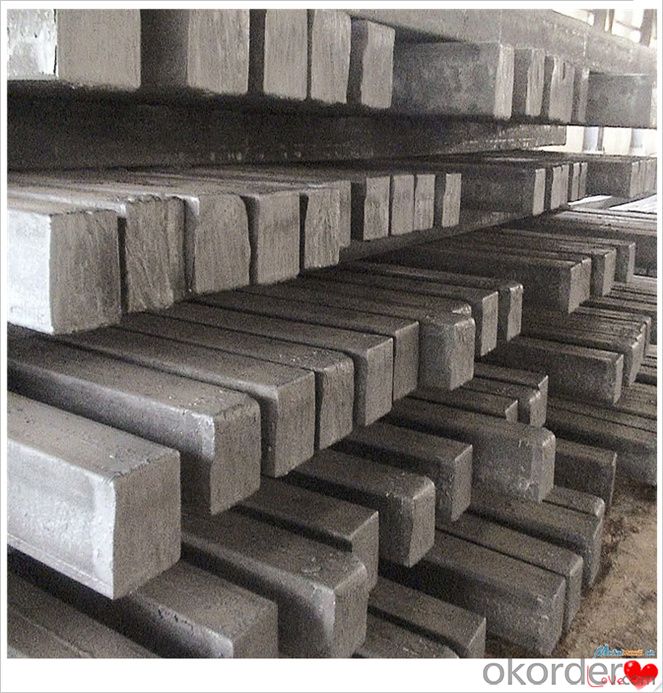
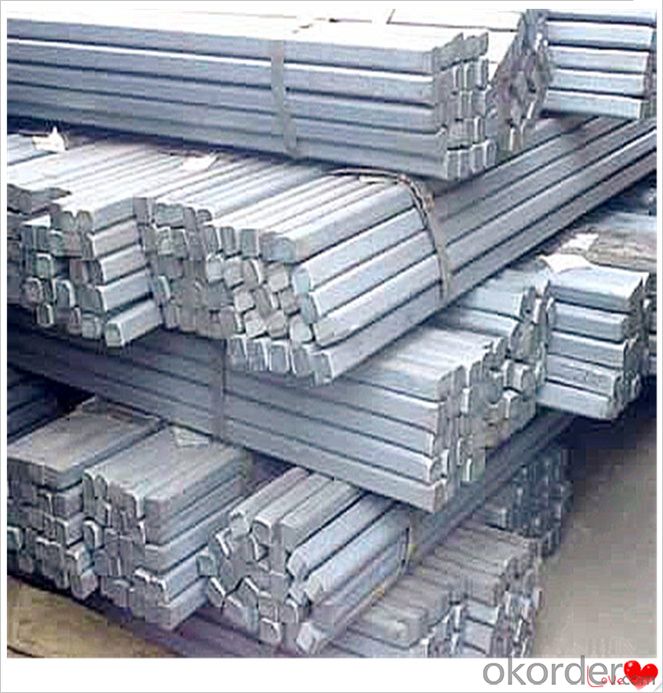
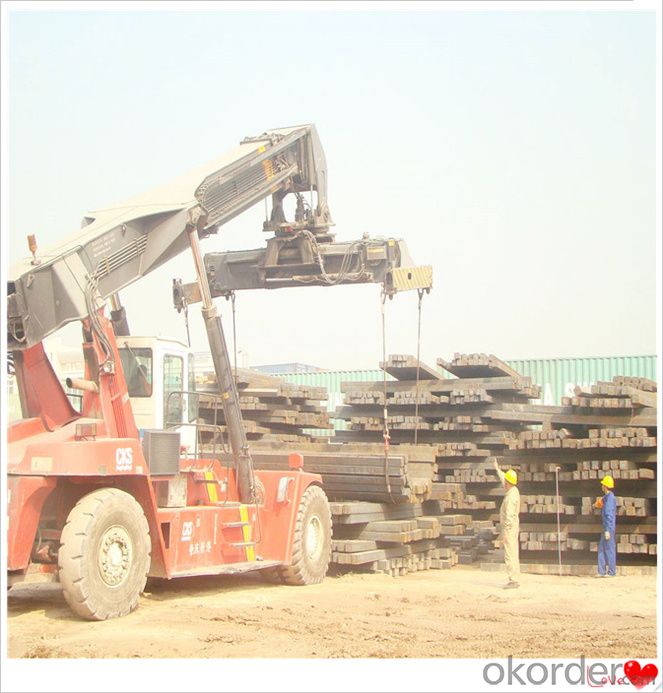
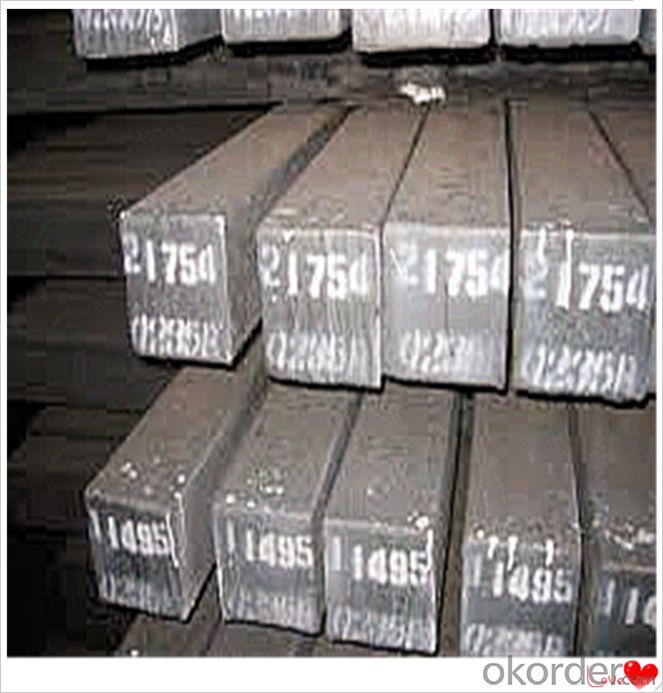
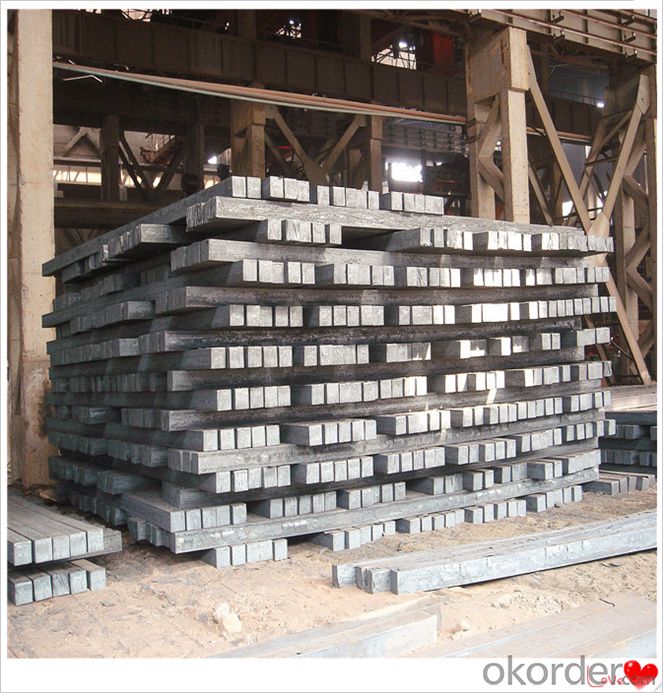
Technical Data
Size:100*100,120*120,150*150,130*130
Mn: 0.3%-0.6%
C: 1%
Cr:0.1%
Packaging
cargo ship or container
usually container price will add 15USD per ton
RFQ
We have organized several common questions for our clients,may help you sincerely:
1) How about your company?
A world class manufacturer & supplier of castings forging in carbon steel and alloy steel,is one of the large-scale professional investment casting production bases in China,consisting of both casting foundry forging and machining factory. Annually more than 8000 tons Precision casting and forging parts are exported to markets in Europe,America and Japan. OEM casting and forging service available according to customer’s requirements.
2) How to guarantee the quality of the products?
We have established the international advanced quality management system,every link from raw material to final product we have strict quality test;We resolutely put an end to unqualified products flowing into the market. At the same time, we will provide necessary follow-up service assurance.
3) How long can we receive the product after purchase?
In the purchase of product within three working days, We will arrange the factory delivery as soon as possible. The pecific time of receiving is related to the state and position of customers.Commonly 7 to 10 working days can be served.
4)Do you have your own QC department?
Yes, we have, our QC department will inspect the goods during the process of mass production and after completion of production.
hot sale!!! steel billets/ mild steel bar/ billet steel
(1): High quality steel with reasonable price.
(2): Wide excellent experiences with after-sale service.
(3): Every process will be checked by responsible QC which insures every product's quality.
(4): Professional packing teams which keep every packing safely.
(5): Trial order can be done in one week.
(6): Samples can be provided as your requirements.
If you are interested in our products, please don't hesitate to contact me.
Your any inquiry will be appreciated and we will offer you a rock-bottom price.
- Q: What are the different shapes and forms of steel billets?
- Depending on their intended use and manufacturing process, steel billets are available in a variety of shapes and forms. Casting is the typical process used to achieve the most common shapes, which include square, rectangular, round, and hexagonal. Square billets are widely used and are often rolled into long products such as bars, rods, and wire. Rectangular billets, with longer sides compared to their width, are also rolled into long products but are typically used for applications that require a larger cross-sectional area. Round billets, as their name suggests, are cylindrical and primarily used for producing seamless tubes, pipes, and other tubular products. The round shape is preferred in these applications as it allows for a more uniform distribution of stresses during manufacturing. Hexagonal billets, with their six sides, are commonly used for forging and machining. Their unique shape provides greater strength and stability, making them suitable for producing high-quality components like bolts, nuts, and other fasteners. In addition to these common shapes, steel billets can also be customized to meet specific requirements in terms of shape and size. Specialized molds or further processing techniques like extrusion or hot rolling can be used to achieve these custom shapes. Overall, the various shapes and forms of steel billets enable the production of a wide range of steel products, each tailored to its specific application and manufacturing process.
- Q: How are steel billets distributed in the market?
- Various channels and processes are utilized to distribute steel billets in the market. These channels can be broadly classified into three main methods: direct sales, distribution networks, and online platforms. Direct sales refer to the direct selling of steel billets by manufacturers or steel mills to customers, such as construction companies, fabricators, or steel service centers. This method allows manufacturers to maintain better control over pricing, quality, and delivery schedules. It also enables them to establish direct relationships with customers and gain insight into their specific requirements. Distribution networks play a significant role in the distribution of steel billets. These networks consist of wholesalers, distributors, and stockists who purchase steel billets from manufacturers and sell them to end-users or smaller retailers. Distribution networks have extensive market coverage, enabling them to serve a wide geographical area. They provide convenience to customers by maintaining an inventory of steel billets, ensuring timely availability, and reducing lead times. In recent years, online platforms have become a popular means of distributing steel billets. These platforms connect buyers and sellers of steel billets, facilitating efficient and convenient business transactions. Manufacturers can reach a global customer base through online platforms, while buyers have access to a wide range of suppliers and can compare prices and specifications. Online platforms also promote transparency and reduce the reliance on intermediaries, resulting in cost savings. Regardless of the distribution method, the transportation and storage logistics of steel billets are crucial. Steel billets are typically transported in bulk using various modes of transportation, such as trucks, trains, or ships. To ensure the quality and integrity of the billets, proper storage facilities equipped with cranes and heavy-duty machinery, such as warehouses or yards, are necessary. Overall, the distribution of steel billets involves a complex network of manufacturers, distributors, and online platforms working together to meet the diverse needs of customers. This ensures a consistent supply of steel billets in the market, supporting industries such as construction, manufacturing, and infrastructure development.
- Q: Use medium frequency furnace (1 million 500 thousand volt ampere) to produce 1 ton cast steel blank, how much kilowatt hour is consumed?
- This depends on the intermediate frequency furnace voltage level and inverter efficiency, the general high voltage will save power, generally 550-700 range, details can refer to wcdlsb site medium frequency furnace data
- Q: What are the advantages of using steel billets over other materials?
- There are several advantages of using steel billets over other materials. Firstly, steel billets have excellent strength and durability, making them ideal for use in various industries including construction, automotive, and manufacturing. Secondly, steel billets can be easily shaped and molded into different forms, allowing for versatility in design and application. Additionally, steel billets have high resistance to corrosion and are capable of withstanding extreme temperatures, making them suitable for both indoor and outdoor use. Lastly, steel billets are readily available in large quantities and are cost-effective, making them a preferred choice for many applications.
- Q: How are steel billets used in the production of shipbuilding materials?
- Steel billets play a vital role in shipbuilding materials as they are necessary for producing strong and durable components. Shipbuilding requires materials that can withstand harsh marine conditions, and steel billets fulfill these requirements. To begin with, steel billets are utilized in the production of different types of steel plates. These plates form the basis of shipbuilding materials and are customized according to specific design needs, such as hull plating, bulkheads, decks, and superstructures. Steel billets provide the essential raw material for creating these plates, ensuring they possess the required strength and structural integrity. Furthermore, steel billets are crucial in manufacturing shipbuilding sections and profiles. These sections, including beams, angles, channels, and other structural components, provide support and reinforcement to the ship's structure. Steel billets are heated and shaped through processes like rolling, forging, or extrusion to form these sections. This allows for the creation of custom-shaped sections that seamlessly integrate into the ship's construction. Additionally, steel billets are also used in producing shipbuilding forgings, which are high-strength components requiring exceptional mechanical properties. Forgings are vital for critical ship parts like propeller shafts, rudder components, and engine parts. Steel billets are heated and shaped using forging techniques to create these components, ensuring they possess the necessary strength, toughness, and resistance to fatigue. In conclusion, steel billets are a fundamental raw material extensively used in shipbuilding. They are transformed into various forms such as plates, sections, and forgings, which are then incorporated into the construction of ships. The utilization of steel billets guarantees that shipbuilding materials meet the stringent requirements for strength, durability, and performance in marine environments.
- Q: What are the main differences between carbon steel and alloy steel billets?
- Both carbon steel and alloy steel billets are utilized in various industries, but they differ in several key aspects. The primary discrepancy between carbon steel and alloy steel billets lies in their composition. Carbon steel billets consist primarily of iron and carbon, with carbon content typically ranging from 0.05% to 2.1%. This renders carbon steel comparatively more cost-effective and easier to manufacture than alloy steel. Conversely, alloy steel billets incorporate additional elements like manganese, nickel, chromium, and molybdenum, which are added to enhance specific steel properties. These alloying elements confer upon alloy steel superior strength, hardness, and resistance to corrosion compared to carbon steel. Another significant distinction between carbon steel and alloy steel billets pertains to their mechanical properties. Carbon steel billets are widely recognized for their high ductility and ease of shaping or forming, making them suitable for applications requiring flexibility and effortless machinability. Conversely, alloy steel billets possess higher tensile strength, toughness, and wear resistance due to the presence of alloying elements. This renders alloy steel billets ideal for applications necessitating high strength and wear resistance, such as in the construction, automotive, and aerospace industries. Moreover, the heat treatment processes for carbon steel and alloy steel billets also vary. Carbon steel billets are frequently subjected to heat treatment to enhance their hardness and strength, with common treatments encompassing quenching and tempering. Conversely, alloy steel billets can undergo a broader range of heat treatment processes, including annealing, normalizing, and precipitation hardening. These heat treatments serve to optimize the properties of alloy steel billets for specific applications, such as increasing strength or improving machinability. In conclusion, the primary disparities between carbon steel and alloy steel billets lie in their composition, mechanical properties, and heat treatment processes. Carbon steel predominantly comprises iron and carbon, while alloy steel incorporates additional alloying elements. Carbon steel possesses high ductility and is easily shaped, whereas alloy steel boasts superior strength, hardness, and resistance to corrosion. The heat treatment processes for these two steel types also differ, with alloy steel affording a wider array of treatment options.
- Q: Are steel billets used in the production of musical instruments?
- Yes, steel billets are commonly used in the production of musical instruments. They are often used to create various components such as keys, valves, and rods, which are essential parts of instruments like saxophones, trumpets, and trombones.
- Q: What are the common surface defects found in steel billets?
- Steel billets commonly exhibit surface defects, including scale, surface cracks, inclusions, decarburization, surface roughness, roll marks, and lamination. Scale, an oxide layer formed during manufacturing, appears as a flaky, rough coating and impacts steel quality. Surface cracks, caused by improper cooling, handling, or excessive stress, weaken the steel. Inclusions, non-metallic impurities like oxides or sulfides, create weak spots. Decarburization, carbon loss from the billet's surface due to high temperatures or inadequate protection, reduces hardness and strength. Surface roughness, irregularities from processing or handling, affects appearance. Roll marks result from issues with rolling mill equipment. Lamination refers to layering or separations within the billet, caused by poor solidification, temperature control, or impurities. Detecting and addressing these defects is crucial for producing high-quality steel. Inspection techniques like visual inspection, ultrasonic testing, magnetic particle testing, and eddy current testing help identify and classify defects.
- Q: What are the different types of steel billets?
- There are several different types of steel billets, each with its own unique characteristics and applications. Some of the most common types include: 1. Carbon Steel Billets: These are the most widely used type of steel billets and are made from iron and carbon. Carbon steel billets are known for their high strength and durability, making them suitable for a wide range of applications, including construction, automotive, and machinery manufacturing. 2. Alloy Steel Billets: These billets are made by adding various alloying elements to carbon steel, such as chromium, nickel, or manganese. Alloy steel billets offer enhanced properties such as increased strength, hardness, and corrosion resistance. They are often used in industries that require high-performance materials, such as aerospace, oil and gas, and power generation. 3. Stainless Steel Billets: Stainless steel billets are made with a high content of chromium, which provides excellent resistance to corrosion and oxidation. They are commonly used in applications where hygiene, durability, and aesthetic appearance are crucial, such as food processing, medical equipment, and architectural structures. 4. Tool Steel Billets: Tool steel billets are specially designed to have high hardness, wear resistance, and heat resistance. They are commonly used to make cutting tools, molds, and dies for various industries, including automotive, manufacturing, and construction. 5. Electrical Steel Billets: Electrical steel billets are made from low carbon steel with specific magnetic properties. They are used in the manufacturing of electrical equipment, such as transformers, motors, and generators, where low energy loss and high magnetic permeability are vital. 6. High-speed Steel Billets: High-speed steel billets are alloyed with elements like tungsten, molybdenum, and cobalt, which enable them to retain their hardness and strength at high temperatures. They are widely used to make cutting tools that need to withstand high-speed cutting operations, such as drills, milling cutters, and taps. These are just a few examples of the different types of steel billets available. The choice of steel billet depends on the specific requirements of the application, such as strength, durability, corrosion resistance, or special properties needed for particular industries.
- Q: What is the role of steel billets in the manufacturing of material handling equipment?
- Steel billets play a crucial role in the manufacturing of material handling equipment as they serve as the primary raw material for forging and shaping various components. These billets are heated, molded, and transformed into different parts such as frames, beams, brackets, and supports, which provide strength, durability, and stability to the equipment. Additionally, steel billets ensure the structural integrity and load-bearing capacity of the material handling equipment, enabling them to withstand heavy loads and rigorous operational conditions.
Send your message to us
Steel Billets Q195-Q235 20mnsi Q235 Q275 Q345 for Fireplace Billet Steel
- Loading Port:
- Dalian
- Payment Terms:
- TT OR LC
- Min Order Qty:
- 100 m.t.
- Supply Capability:
- 50000 m.t./month
OKorder Service Pledge
OKorder Financial Service
Similar products
Hot products
Hot Searches
Related keywords
